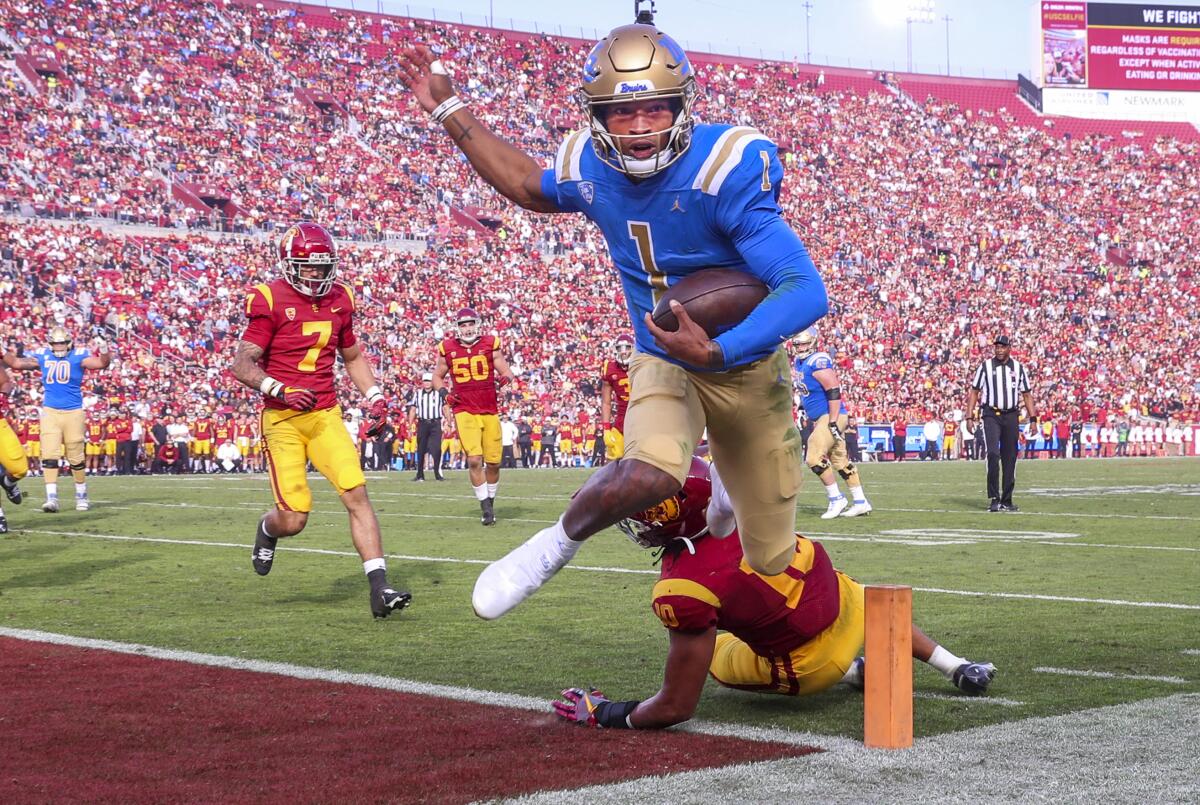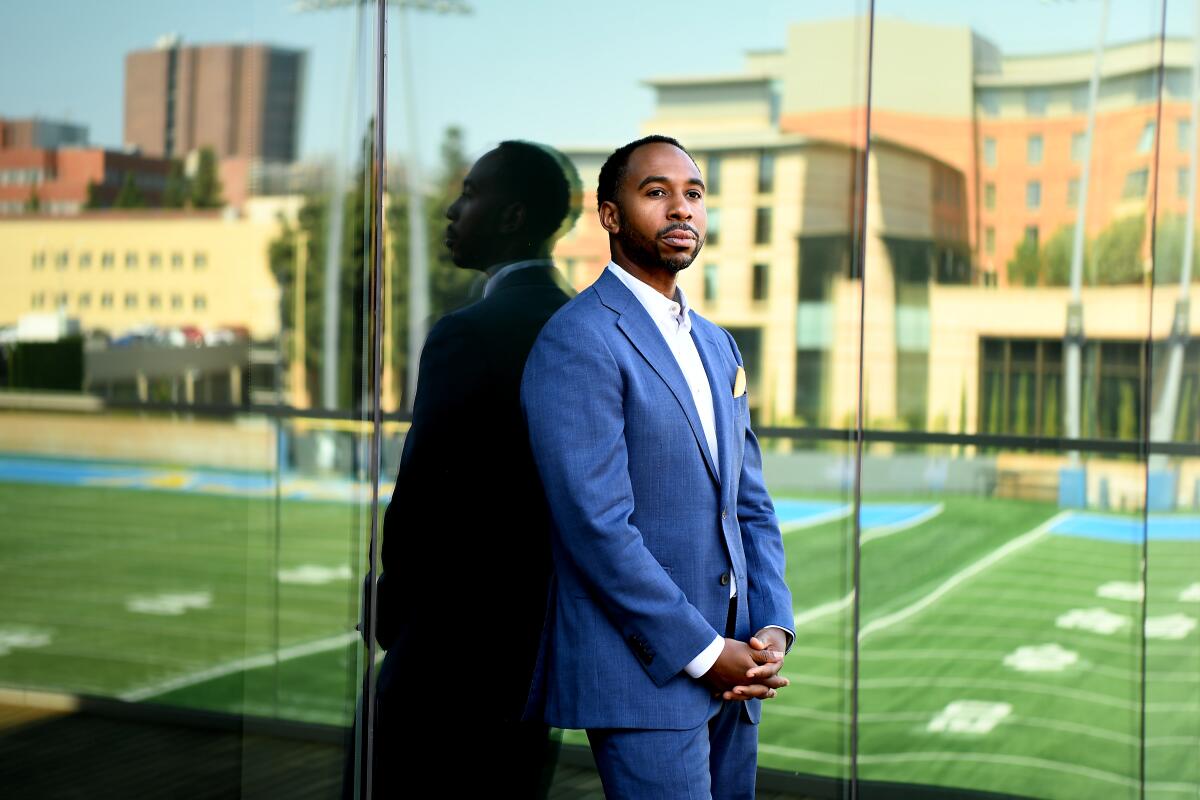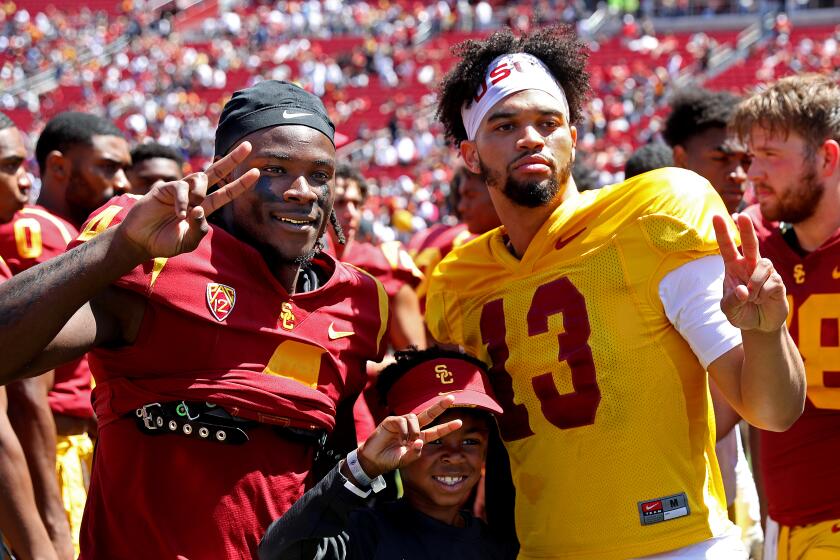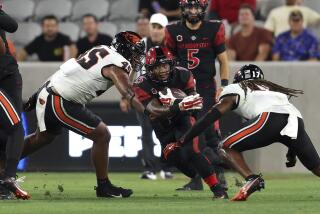USC and UCLA rock college sports by leaving the Pac-12 for the Big Ten

- Share via
It may be hard to imagine — USC cardinal and gold and UCLA blue and gold blending into the pageantry that permeates through frosty fall Saturdays in America’s heartland.
It may be hard to imagine — Trojans and Bruins annually competing with Ohio State Buckeyes and Michigan Wolverines for conference championships and bragging rights instead of Oregon Ducks and Washington Huskies.
But Thursday, when USC and UCLA officially announced they are leaving the Pac-12 for the Big Ten Conference, college sports fans from coast to coast were forced to conjure up a vision that what would have once — in simpler times, perhaps — seemed unthinkable.
The Trojans and Bruins, both of whom have been trying to reclaim past football glory with varying degrees of desperation, came together and completed a shocking move that will forever alter the national college sports landscape.
The Big Ten presidents and chancellors formally accepted their applications for membership Thursday afternoon, but the work that went into getting to the finish line began many months ago as the crosstown rivals assessed their respective futures in an increasingly unstable Pac-12 Conference. For each, the compass continued to point them eastward to plentiful Big Ten paydays.
With players being paid, universities have to follow the money, and UCLA and USC are making a smart move by leaving the Pac-12 for the Big Ten Conference.
The schools’ Midwestern migration will begin on Aug. 2, 2024, and include all sports except beach volleyball, men’s volleyball and men’s and women’s water polo.
“This is the most volatile and uncertain era in the history of American collegiate athletics,” USC athletic director Mike Bohn said in a statement. “USC must ensure it is best positioned and prepared for whatever happens next, and it is our responsibility to always evaluate potential opportunities and be willing to make changes when needed. Ultimately, the Big Ten is the best home for USC and Trojan athletics as we move into the new world of collegiate sports.”
UCLA athletic director Martin Jarmond told The Times, “College athletics is changing, and UCLA has always led in times of change. For the sake of our student-athletes, and for preserving the legacy of Bruin excellence, we cannot afford to stand still.”
This new, changing world Bohn and Jarmond referred to is one in which college athletes for the first time can earn money from the use of their name, image and likeness (NIL) — a right the NCAA and its member schools long denied to players in the name of the ideals of amateurism.
With so much unknown about where athlete compensation is headed beyond NIL, USC and UCLA leaders felt they had to address the long-term financial viability of their programs.

“As the oldest NCAA Division I athletic conference in the United States and with a footprint that will now extend from the Pacific to the Atlantic, Big Ten membership offers Bruins exciting new competitive opportunities and a broader national media platform for our student-athletes to compete and showcase their talents,” UCLA chancellor Gene Block and Jarmond said in a joint letter. “Specifically, this move will enhance name, image and likeness opportunities through greater exposure.”
USC and UCLA have been flagship members of the Pac-12, the West Coast’s power conference, for nearly a century. Their departure to the Chicago-based Big Ten signifies a death blow to the notion of the Pac-12 as a competitive, top-level football conference and serves to bolster the Big Ten in its efforts to keep up with the Southeastern Conference, which last summer grew to 16 teams with the addition of Big 12 schools Texas and Oklahoma.
The Trojans and Bruins will boost the Big Ten to 16, too, and there’s a chance the league will continue to add members. Multiple sources told The Times Thursday, however, that no other Pac-12 members are expected to be added to the Big Ten at this time.
“This decision was made after serious deliberation and analysis, and with great appreciation and respect for our Pac-12 colleagues with whom we have enjoyed a wonderful history and relationship,” USC president Carol Folt said in a statement.
The move, Folt added, “positions USC for long-term success and stability.”
The Pac-12 has lagged behind other major conferences for years in media rights revenue, distributing $344 million among its schools in the 2021 fiscal year. In the same year, the Big Ten handed out $680 million.
The Big Ten is currently negotiating its next media rights deal and is expected to be able to fetch upwards of $1 billion per year. Adding the Southern California media market to its product will only make the league’s offerings more desirable at just the right time.
USC and UCLA’s decision to join the Big Ten in 2024 will make a significant impact in the college sports world. Here’s a breakdown of what the move means.
Pac-12 commissioner George Kliavkoff stressed a commitment to fixing his league’s prolonged football struggles during his first year in the position. Kliavkoff also understood how crucial USC would be in improving that standing. When the new commissioner toured the Pac-12 footprint last summer, he made a point of visiting USC’s campus first.
In conference realignment, the attractiveness of a university’s football brand has always been the driving factor. That certainly gave USC — with its 11 national championships and six Heisman Trophies on display at Heritage Hall — more leverage in charting its course than UCLA, which has of course won 11 national titles in men’s basketball. The Bruins still landed on safe footing, and the crosstown rivalry will live on under a new conference’s banner.
With the Big Ten and SEC lapping the Pac-12 in revenue and football success during the past decade, USC in recent years has been continuously evaluating its options for future conference alignment, even considering joining rival Notre Dame as an independent. Texas’ and Oklahoma’s move from the Big 12 to the SEC in July 2021 made it clear momentous changes were already afoot and accelerated the Trojans’ push to secure themselves a seat at the leadership table for whatever is to come during a tumultuous time in college athletics.

“I don’t believe there’s a college administrator in the country that didn’t recognize that clearly there were two conferences that were separating themselves from everyone else,” Bohn told The Times. “That particular move further emphasized that. But it’s about providing the best stage and opportunity for our athletes. Clearly, that’s the Big Ten opportunity.”
USC joining the Big Ten — coming on the heels of the stunning hiring of head football coach Lincoln Riley in late November — furthers the message that the Trojans are committed to returning to their traditional stature as national title contenders.
That was the promise made by Bohn when he was hired as USC’s athletic director in November 2019. Bohn was well aware at the time of the issues facing the conference, which made several missteps during the course of then-commissioner Larry Scott’s turbulent 11-year tenure.
USC’s influence in the Pac-12 had also declined over that period, as former athletic director Lynn Swann never took an active role at the conference level. Bohn immediately took the opposite approach upon taking over, showing that USC planned to sit at the head of the conference table.
In orchestrating its exit, USC has instead flipped the table over entirely.
As name, image and likeness compensation rules hit the one-year mark, The Times provides a Q&A covering what has happened and what’s likely to come.
The Pac-12’s revenue issues are hard to deny, even with the prospect of an improved media rights package starting in 2024.
ESPN has made a significant investment in the SEC, and Fox is currently helping negotiate licensing deals on behalf of the Big Ten. There is uncertainty about where the Pac-12 may fit into networks’ plans for 2024 and beyond, and the conference losing two of its bellwether programs won’t help in negotiations.
“While we are extremely surprised and disappointed by the news coming out of UCLA and USC today, we have a long and storied history in athletics, academics, and leadership in supporting student-athletes that we’re confident will continue to thrive and grow into the future,” the Pac-12 said in a statement.
In moving to the Big Ten, USC and UCLA also solve another issue that’s long plagued the Pac-12: Kickoff times. Both schools were often relegated to the late window on Saturday nights, neither often finishing before half the country was asleep.
“For our fans, Big Ten membership equates to better television time slots for our road games, but the same number of home games either at the Rose Bowl, in Pauley Pavilion or other UCLA venues,” Block and Jarmond wrote.
As members of the Big Ten, late kickoffs are almost assuredly a relic of the past. The most glaring problem for the Pac-12, however, has long been what happened after kickoff.
The Pac-12 has not had a team reach the College Football Playoff since Washington in 2016. Only one other team — Oregon in 2014 — has made it.
Local high school recruits react with shock to UCLA and USC leaving the Pac-12 for the Big Ten.
USC’s failure to find stability in the aftermath of Pete Carroll’s departure and NCAA sanctions 12 years ago have hurt the conference’s competitiveness nationally. But now the Trojans are taking a step out on their own, leaving behind long-held relationships for new blue-blood bedfellows such as Ohio State and Michigan. UCLA’s decision to come along for the ride should help what may be an awkward two-year transition.
Block and Jarmond acknowledged the additional travel burden but added, “The resources offered by Big Ten membership may allow for more efficient transportation options. We would also explore scheduling accommodations with the Big Ten that best support our student-athletes’ academic pursuits.”
“We recognize these are big changes,” Block and Jarmond added. “We value the talent and dedication of our student-athletes as well as the passion of Bruins fans far and wide. The best way to respect that is to protect our program from the great uncertainty it would face if we did not make this transition.”
USC and UCLA are leaving the Pac-12 for the Big Ten Conference in 2024, the two schools announced Thursday.
More to Read
Go beyond the scoreboard
Get the latest on L.A.'s teams in the daily Sports Report newsletter.
You may occasionally receive promotional content from the Los Angeles Times.



















